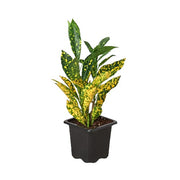
Price Match Guarantee:
If you find the same plant at another online shop for a better price, we will match it.**Exempt are online garden centers and DIY markets and sales offers.

Free Shipping
On orders over $85.
Croton 'Gold Dust'
The Croton 'Gold Dust' boasts a speckled pattern of gold “dust”.
It looks like the plant was splattered with bright yellow paint on their emerald green foliage. Thankfully, the Croton is low maintenance and requires very little to thrive. It loves bright, indirect to medium light to keep its colors vibrant. Keep in mind that the plant is native to the Western Pacific Islands and Australia.
Grow Pot Size: 3" and 4”
Overall Height Including Grow Pot: 6-12” depending on grow pot size.
Plant Care Level: Easy
Key Benefits
Symbolizing change, the Croton ‘Gold Dust’ is a welcoming reminder of the constant changes that are taking place. Use the croton as a mindfulness tool. Embrace the season and all that comes with it.
Croton ‘Gold Dust’ Care Tips
- Binomial Name: Codiaeum variegatum ‘Gold Dust’
- Care Level: Easy
- Light: Bright indirect
- Water: Allow the top 2” of the soil to dry
- Pet Friendly: No
The Croton ‘Gold Dust’ Story
Where is it from?
The Croton ‘Gold Dust’ can be found growing throughout Australasia and the Oceanic region.
Who is the Croton ‘Gold Dust’?
The Croton ‘Gold Dust’ is aptly named for its splattered yellow variegation. The Croton ‘Gold Dust’ is a cultivar of croton. Croton’s were first described by Carl Linnaeus in 1753.
Good For You!
Privacy! In the Southern hemisphere where temperatures do not drop below 50F, The croton plant is commonly used as hedges and patio plants. Providing some privacy between neighbors.
Breath Deep! The Croton is a natural air purifier! Naturally filtering out common household toxins and pollutants.
Is the Croton ‘Gold Dust’ the right plant for me?
While the Croton is relatively easy to care for the plant does require regular maintenance. Happy crotons will grow quite quickly and will require light pruning on a regular basis to keep them healthy and clean-looking. In the early fall, your croton may begin to bloom. Blooms can become quite messy if allowed to naturally fall off, the same can be said for their fruit.
Provide lots of bright indirect light to keep the bright variegation. Low light will cause the leaves to revert back to solid green!
Pet Friendly: No! The croton belongs to the Euphorbiaceae family, this family of plants should not be consumed.
Location Suggestions: We suggest keeping your plant in a room with a bright light! Living rooms and kitchens are perfect. In the summer you can even pop your croton outside if the temperatures are consistently above 65F.
Care Instructions
Light
Bright indirect to medium light.
Water
Allow the top 2” of the soil to dry in between watering
Repotting
This can be done every 12-18 months. Choose a pot that is 2” larger in diameter than the original pot.
Soil
Use a well-draining, high organic matter soil mix.
Temperature
Average from 65°F - 75°F
Feeding
Follow a monthly fertilizing schedule when the plant is actively growing. In most cases, this is in the spring and summer. Use a balanced fertilizer - this means a ratio of NPK that is all the same. Ex: 10-10-10.
Grooming
Gently wash the leaves of dust and debris with a showerhead and remove any dead or dying foliage.
Care
The brighter the location, the more intense the variegation will be.
General Information About Your Plant
Origin
Indonesia, Malaysia, Australia, and the western Pacific Ocean islands,
Leaves
The leaves are dusted in gold speckles.
Toxicity
Toxic

Price Match Guarantee:
If you find the same plant at another online shop for a better price, we will match it.**Exempt are online garden centers and DIY markets and sales offers.

Free Shipping
On orders over $85.














